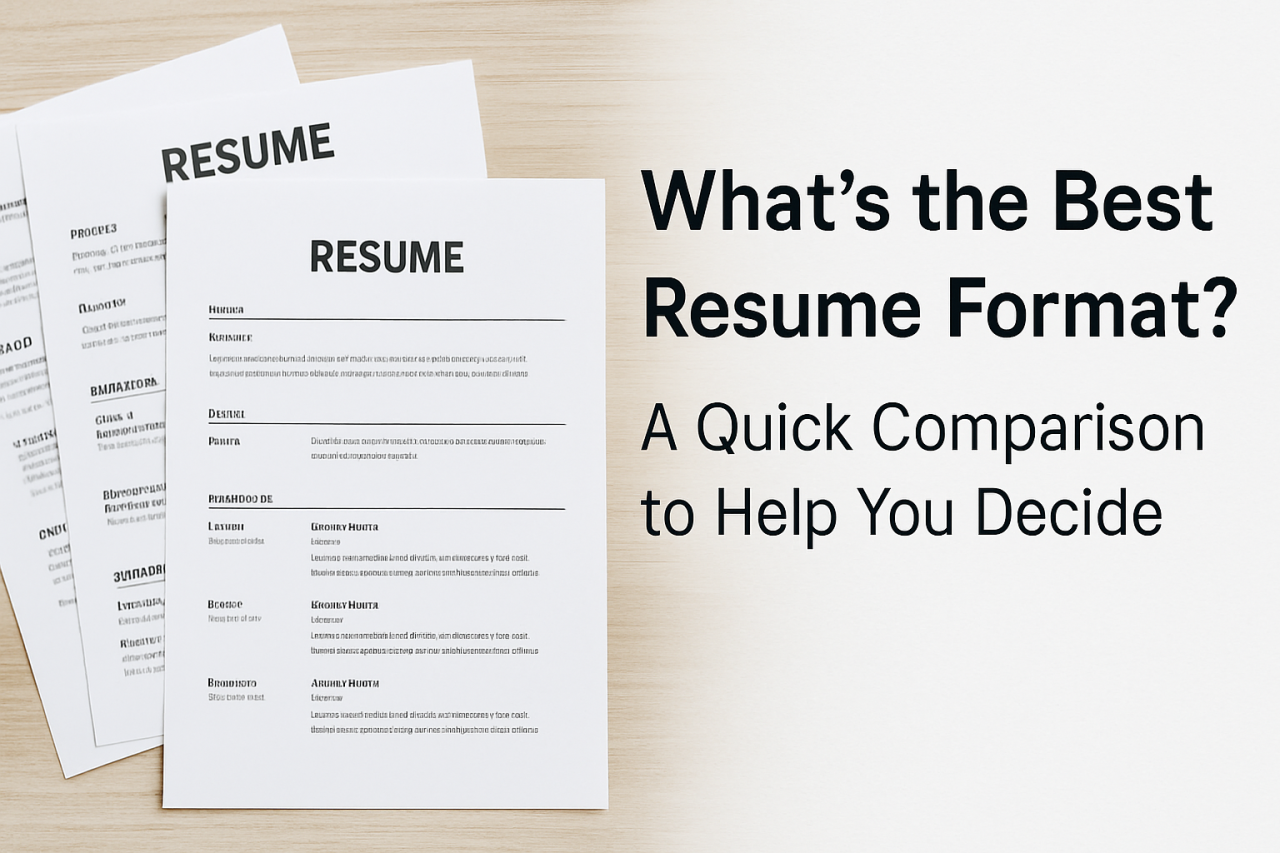What’s the Best Resume Format? A Quick Comparison to Help You Decide

Discover the best resume format for your career. Compare chronological, functional, and hybrid resumes to choose the right fit for your goals.

Table of Contents
- Why Resume Format Matters
- The 3 Most Common Resume Formats
- Other Resume Formats and When to Use Them
- Technical Considerations
- Crafting Content That Matches the Format
- How to Make Sure Your Resume Is ATS-Friendly
- Which Format Is Best for You?
- Build Your Resume With the Right Tools
Why Resume Format Matters
In today’s competitive job market—especially in technical fields like electrical engineering—your resume format can make or break your application. Most employers use Applicant Tracking Systems (ATS) to screen candidates, and if your resume format isn't optimized for these systems, your application might never be seen.
Your resume format needs to:
- Be ATS-friendly: clean, simple, and structured
- Be industry-appropriate: aligned with electrical engineering expectations
- Be strategically organized: to highlight your most relevant experience and skills
The right format helps tell your story clearly—whether you're a fresh graduate, a field engineer, or a protection system specialist.
The 3 Most Common Resume Formats
1. Reverse Chronological Resume
The most common format, listing your work history starting with the most recent role. Ideal for professionals with a steady career path.
Best for:
- Engineers with consistent job progression
- Those in core engineering or design roles
- Job seekers targeting roles that align with their current trajectory
Pros:
- ATS-compliant
- Familiar to recruiters and hiring managers
- Highlights promotions and career growth
Cons:
- Work gaps or career changes are more visible
- May not work well if you're switching industries or re-entering the workforce
2. Functional (Skills-Based) Resume
This format puts the spotlight on skills rather than job titles or dates. Perfect for those changing industries or returning after a career break.
Best for:
- Career switchers (e.g., from construction to energy sector)
- Fresh graduates with strong academic projects
- Freelancers or those with varied experience
Pros:
- Shifts focus to capabilities
- Hides employment gaps
- Useful for highlighting transferable skills
Cons:
- Less familiar to recruiters
- Risk of being rejected by some ATS systems
- Needs strong project or skill evidence to support claims
3. Combination (Hybrid) Resume
A blend of both functional and chronological formats. It starts with a skills summary and follows up with detailed work history.
Best for:
- Mid to senior-level engineers
- Professionals with diverse experience across roles and industries
- Those needing to showcase technical and leadership experience
Pros:
- Balanced structure for skills and experience
- Versatile across different job applications
- Emphasizes both accomplishments and capabilities
Cons:
- Can become too long if not carefully edited
- Needs careful formatting to ensure ATS compatibility.
Other Resume Formats and When to Use Them
Profile Resume:
Begins with a compelling “About Me” section. Great for freshers or experienced professionals who want to frame their story upfront.
Targeted Resume:
Customized for each job. You adjust the content to mirror the job description—ideal for applying to niche roles like relay coordination engineer or HVDC simulation specialist.
Infographic Resume:
Highly visual and best reserved for creative roles. Not suitable for ATS, so only use when handing over your resume in person or during networking.
Mini Resume:
A short, one-paragraph summary of your experience, useful during job fairs or networking events—not meant for formal applications.
Technical Considerations
- Use standard fonts: Arial, Calibri, or Times New Roman (10–12 pt)
- Save as PDF unless otherwise specified
- Avoid charts, tables, and images for important content
- Use clear section titles: “Work Experience,” “Education,” “Projects,” etc.
Crafting Content That Matches the Format
Reverse Chronological Example:
“Performed arc flash analysis and protective device coordination for a 220 kV substation using ETAP, resulting in 30% improvement in response time.”
Functional Example (Grouped by Skill):
Power System Modelling
“Built load flow and short circuit models in PSCAD and ETAP for renewable integration studies.”
Combination Example (Skills Summary + Experience):
Top Skills
- Relay coordination
- Substation design
- AutoCAD and EPLAN drafting
Work Experience
Electrical Design Engineer | PowerTech Pvt Ltd
Jan 2020 – Present
“Led detailed design of 66/11 kV GIS substation with integrated SCADA system.”
How to Make Sure Your Resume Is ATS-Friendly
- Stick to text-based formatting
- Avoid non-standard section titles like “My Journey”
- Use keywords from the job description (e.g., “Load Flow Study,” “Transformer Sizing”)
Don’t bury key info inside graphics or text boxes.
Which Format Is Best for You?
| Situation | Recommended Format |
| Fresh Graduat | Reverse Chronological or Hybrid |
| Career Switch | Career Switch |
| Freelancer/Consultant | Combination |
| Senior-Level | Combination or Reverse Chronological |
| Job Gaps | Functional or Hybrid |
Build Your Resume With the Right Tools
At ATVM Workforce Solution, we support candidates in choosing the right resume format, crafting content tailored to job roles, and ensuring your resume is ATS-optimized. Whether you're applying for a substation design job, a field testing role, or a system studies position, your resume must be clear, strategic, and results-driven.
Need help getting your resume right?
Connect with the ATVM resume optimization team today.
Let your resume format highlight not just what you've done—but how you're the best fit for the job ahead.
Categories: : Resume
 Kalaivani Ramprasad
Kalaivani Ramprasad 